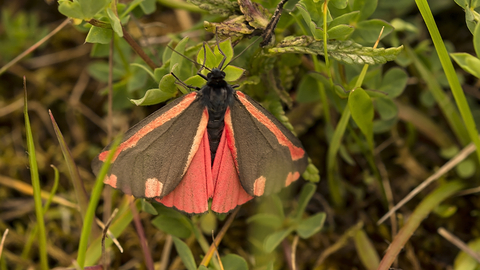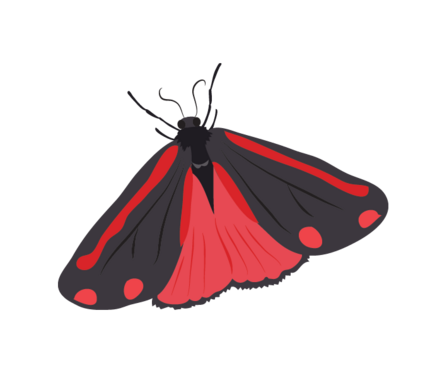
©Bob Coyle
Cinnabar
Scientific name: Tyria jacobaeae
The cinnabar is well-known for its love of ragwort plants - look for a striking black-and-red moth that flies during both day and night in grasslands, gardens, waste ground, pastures and hedgerows.
Species information
Category
Statistics
Wingspan: 3.4-4.6cmConservation status
Priority Species under the UK Post-2010 Biodiversity Framework.
When to see
May to AugustAbout
The cinnabar is a moth of rough grassland and hedgerows, gardens and waste ground, where the black-and-yellow-banded caterpillars feed on common ragwort, other ragworts and groundsels. Adults are on the wing during the summer, flying in the sunshine, but also at night. They are easily disturbed, fluttering up from their feeding plants. The caterpillars pupate in autumn, spending the winter as cocoons on the ground, before emerging as moths the following summer. The bright colouring of the adults and caterpillars warns predators that they are unpalatable, having ingested the poisonous ragwort plants.How to identify
The cinnabar is slate-black with two red spots and two pinky-red stripes on the rounded forewings. Its hindwings are pinky-red and bordered with black. It can be distinguished from the similar burnet moths by its broader wings and red bars instead of spots.Distribution
Widespread.Did you know?
The cinnabar is named after the red mineral, Cinnabar, an ore of the metal Mercury.How people can help
The Wildlife Trusts work closely with farmers and landowners to ensure that our wildlife is protected and to promote wildlife-friendly practices. By working together, we can create Living Landscapes: networks of habitats stretching across town and country that allow wildlife to move about freely and people to enjoy the benefits of nature. Support this greener vision for the future by joining your local Wildlife Trust.Illustration of a cinnabar moth

Corinne Welch
